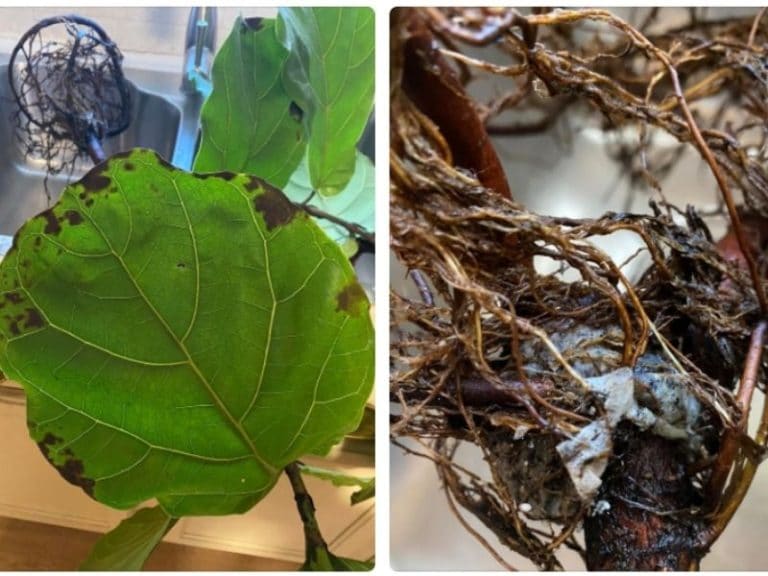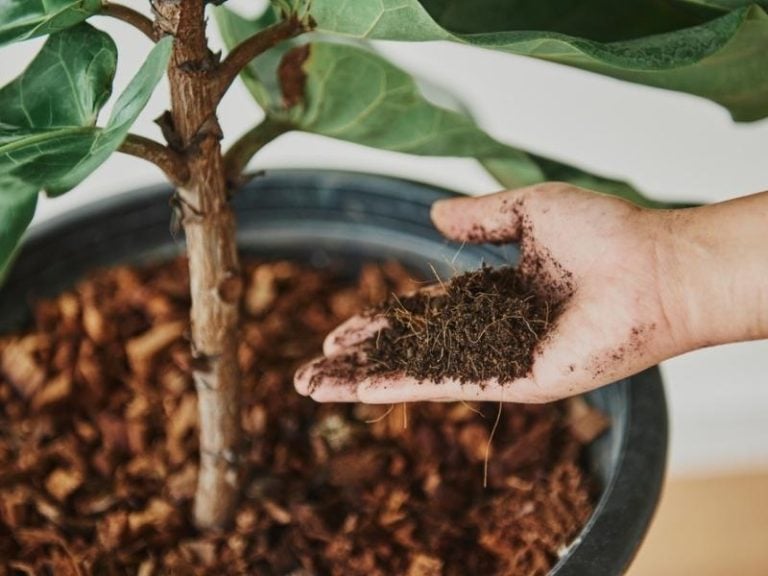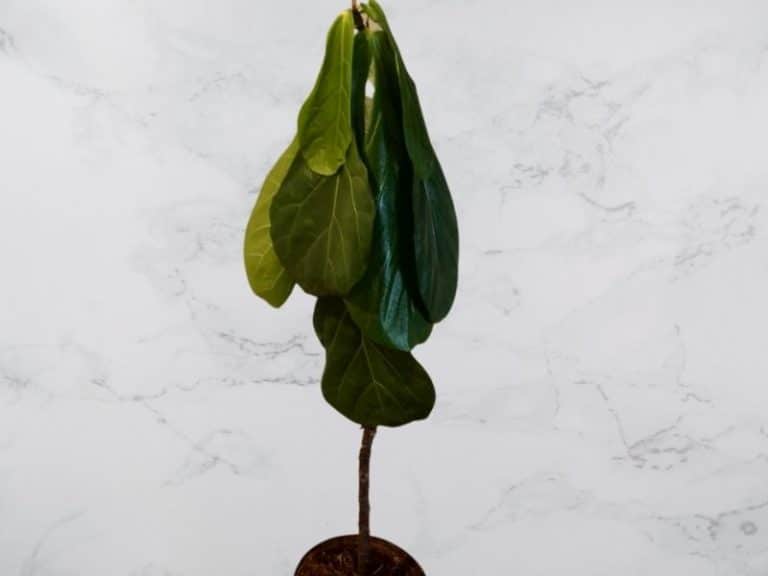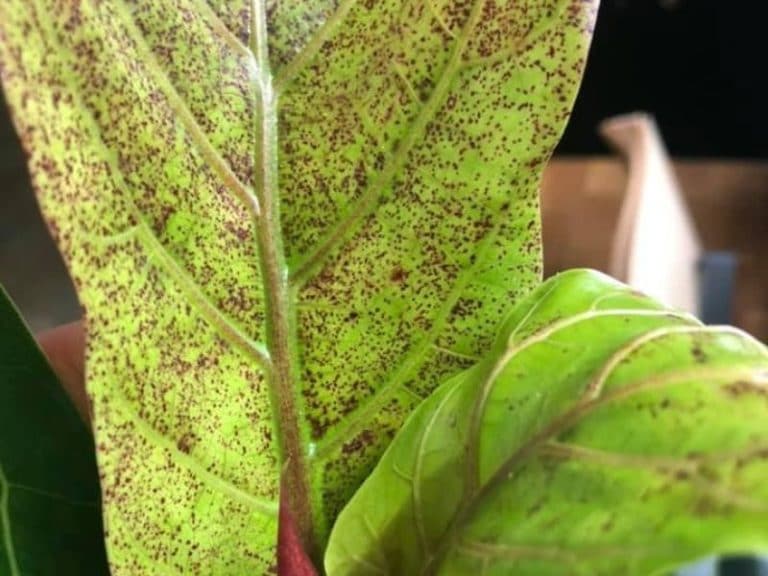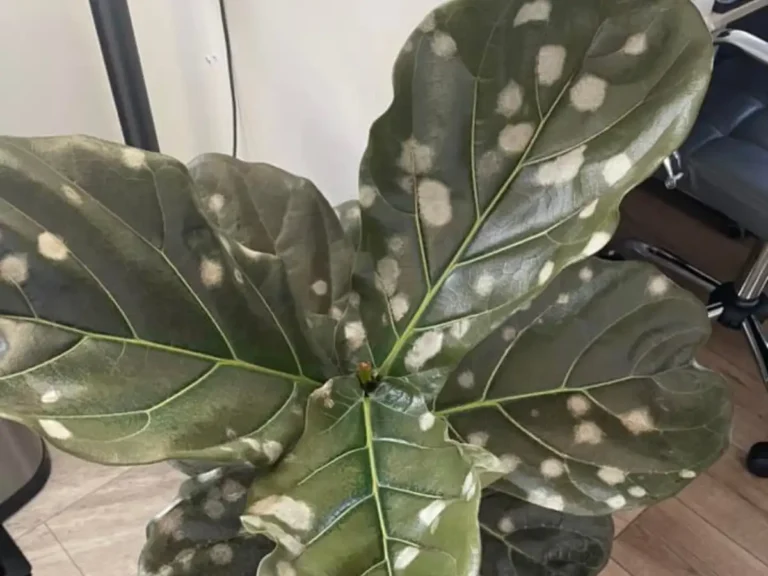Fiddle Leaf Fig Yellow Leaves: Causes and Fixes
Fiddle leaf figs are beloved houseplants due to their lustrous green leaves. So, it’s usually concerning when these leaves turn yellow due to overwatering, low-light conditions, lack of nutrients, and a host of other factors.
You can fix leaf yellowing in fiddle leaf figs by modifying your watering cycle, providing bright indirect light, and feeding the plant with fertilizer. Also, correct the soil pH to 6.6 – 7 and allow the plant to acclimatize after repotting it to stop the leaves from yellowing.
Why are the leaves on my fig tree turning yellow?
If your fiddle leaf fig tree has yellow discoloration on the leaves, it’s likely that the plant is overwatered, underfed, or receiving insufficient light. Other less common causes of Ficus lyrata leaf yellowing include transplant shock, pest infestation, and acidic soil.

Here’s why the leaves of your fiddle leaf fig are turning yellow:
Overwatering
The most common cause of Ficus lyrata leaf yellowing is overwatering. You’re most likely to overwater your fiddle leaf fig if you irrigate it too often or if the soil is slow-draining. As the soil becomes waterlogged, it becomes an attractive habitat for various types of fungi which trigger root rot in the fig plant.
With the roots diseased, absorption of nutrients is affected, consequently hampering the production of chlorophyll in the leaves of the fiddle leaf fig. Minimal chlorophyll production in the leaves causes the most nutrient-deprived leaves to start spotting shades of pale green and yellow.
Drooping fiddle leaf fig leaves may also present in addition to yellowing as a sign that the plant is sitting in soggy soil and may be developing root rot.
Inadequate Light
Fiddle leaf figs are native to the rainforests of West Africa, where they receive lots of bright, indirect sunlight. As such, low light conditions may trigger leaf yellowing in this plant. This is especially common in indoor fiddle leaf figs kept in a dark room.
Note: Apart from nutrients, plants also need sunlight to make chlorophyll. Fiddle leaf fig, being a sunlight-loving plant, finds it hard to make chlorophyll in low-light conditions, resulting in leaf yellowing.
Nutrient Deficiency
As already mentioned, plants need nutrients to make chlorophyll, with a shortage of nutrients triggering leaf yellowing. However, it’s not always that the plant can’t absorb enough nutrients due to rotten roots caused by overwatering and root rot fungi. It could be that the soil in which your fiddle leaf fig grows simply doesn’t have enough nutrients to support generation of chlorophyll.
This is especially common in potted fiddle leaf figs, as their root systems are restricted and thus can’t grow deeper into the soil in search of nutrients. Potted Ficus lyrata plants that are under-fertilized are most vulnerable to yellowing caused by nutrient deficiency.
Transplant Shock
If you notice that your fiddle leaf fig is starting to turn yellow after you recently repotted it or transplanted it from a pot to your outdoor garden, the most likely cause is transplant shock. As you move your fig plant from one spot/container to another, it experiences physical shock due to the significant changes in the environmental conditions.
This causes the plant to stress out. Before the plant adapts to the sunlight, humidity, temperature, and soil conditions of its new environment, the leaves may turn light green or yellow.
Acidic soil
Fiddle leaf fig trees thrive in neutral soil Ph conditions. As such, when your potting soil mix becomes too acidic over time, the plant may show signs of stress, including leaf yellowing. Your soil acidity may increase due to various factors, such as using ground coffee as a fertilizer or spraying the plant with a homemade, vinegar-based fungicide, which then leeches into the soil.
Pest infestation
Though not a common cause of fiddle leaf fig leaf yellowing, various pests like aphids and mealybugs may also cause foliar damage that manifests as yellow discoloration. As these pests feed on the leaf sap, they cause the leaves to lose vigor and turn yellow.
How to fix leaf yellowing in fiddle leaf figs
To control leaf yellowing in your fiddle leaf fig plant, change your watering schedule, ensure good drainage, provide optimal light conditions, and feed the plant with fertilizer. Undertaking post-transplant maintenance, repotting in neutral Ph soil, and undertaking pest control measures will also fix Ficus lyrata leaf yellowing.
1. Change your watering schedule to once every 7-10 days
To treat leaf yellowing caused by overwatering, slow down your hydration frequency. Generally, watering once a week should suffice. However, depending on the soil and temperature conditions, this may still be too much. That’s why it’s advisable to check for topsoil dryness before watering your fiddle leaf fig again.
Use a moisture meter or insert a finger into the soil to determine if it’s dry enough to be watered again. Finally, cut back on watering outdoor fiddle leaf figs during rainy seasons and winter.
2. Improve the plant’s drainage
If the excessive soil moisture is due to compact garden soil that doesn’t drain well, consider tilling the soil to ensure proper drainage and aeration. Meanwhile, for potted fiddle leaf figs, you may have to repot the plant.
The new soil mix should contain coarse sand for faster drainage. Meanwhile, if the old growing pot lacks drainage holes at the bottom, replace it with one that does.
3. Provide bright indirect light
If the leaves of your indoor fiddle leaf fig are turning light green/yellow due to inadequate light conditions, move them to a spot near the window where they’ll receive bright indirect sunlight. Alternatively, you can install artificial grow lights.
Meanwhile, for outdoor fiddle leaf figs that are heavily shaded by taller garden plants, consider transplanting them in a new spot where they’ll receive adequate sunlight. With no thick canopies hindering sunlight transmission, the leaf yellowing problem should disappear within a few weeks.
Note: Fiddle leaf figs love bright, but indirect sunlight. As such, avoid placing your fig plant on a West-facing window sill, as this exposes it to scorching, direct sunlight in the afternoon.
4. Feed the plant with a 3:1:2 NPK fertilizer
If the leaf yellowing is being caused by plant starvation, feed the soil with a fertilizer that has a 3:1:2 NPK ratio. Fiddle leaf figs need more nutrients during the growing season. As such, ensure to fertilize your fig plant at least once a month from spring-summer.
Note: The NPK ratio refers to the proportions of nitrogen, phosphorus, and potassium nutrients present in the fertilizer. A 3:1:2 ratio is the best for fiddle leaf figs, as it facilitates sufficient energy production while minimizing the risk of excess residual nutrient salts (especially phosphorus) in the soil.
5. Repot in neutral pH soil
If your Ficus lyrata leaves are turning yellow due to highly acidic soil, repot the plant in a soil mix with neutral pH. Alternatively, you can apply alkaline drops to lower the soil acidity to a pH of 6.5-7.
Another common way of lowering the acidity of the soil is by adding a liming material. These include different types of ground limestone, including granular, hydrated, pulverized, granular, and pelletized lime.
6. Acclamitize the plant after repotting
Transplant Shock that leads to leaf yellowing in fiddle leaf figs can be controlled by taking various transplant aftercare measures. For starters, water the plant thoroughly to minimize transplant shock.
Also, try to maintain the same temperature conditions the plant was used to before it was transplanted. Another helpful measure is to keep the fiddle leaf fig in the same spot even after repotting.
7. Get rid of pests on your fiddle leaf fig
For Ficus lyrata leaf yellowing caused by pests like aphids and mealybugs, apply a suitable pest control measure:
- Introduce natural predators that feed on mealybugs, including lacewings, ladybugs, and parasitic wasps.
- Undertake physical control for light mealybug and aphid infestations by spraying your fiddle leaf fig foliage with a jet of water. The water will dislodge the pests off the plant.
- Wipe the leaves with organic pesticides such as isopropyl alcohol, horticultural oil, and neem oil. Diatomaceous earth is also very effective against aphids.
- Dust aphid-infested fiddle leaf fig leaves with flour to constipate the insects.
Should you remove the yellow leaves?
If you find the yellow leaves of your fiddle leaf fig to be aesthetically displeasing, prune them off using a sterilized pair of scissors or pruning shears. What’s more, removing the stressed-out leaves gives the plant a chance to redirect its energy towards growing new, healthy foliage.
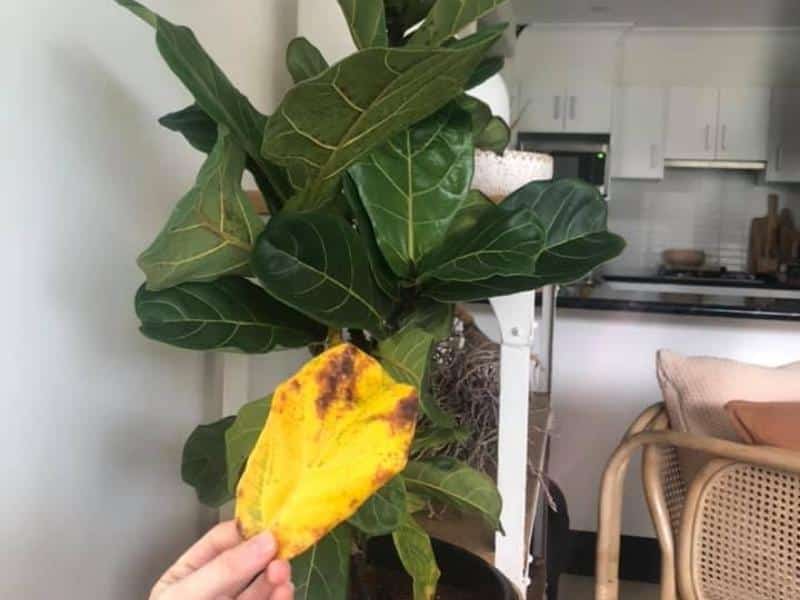
Can yellow leaves turn green again?
Unfortunately, fiddle leaf fig leaves that are already yellow won’t go back to being green again. The aforementioned treatment solutions only work to eliminate the cause of yellowing. This ensures that any leaves that are still green, plus new growth don’t turn yellow as well.
Pro tip: If the leaf yellowing is severe and the plant is about to die, you can still propagate new Ficus lyrata plants from stem cuttings.
READ NEXT: BACTERIAL LEAF INFECTION IN FIDDLE FIGS


